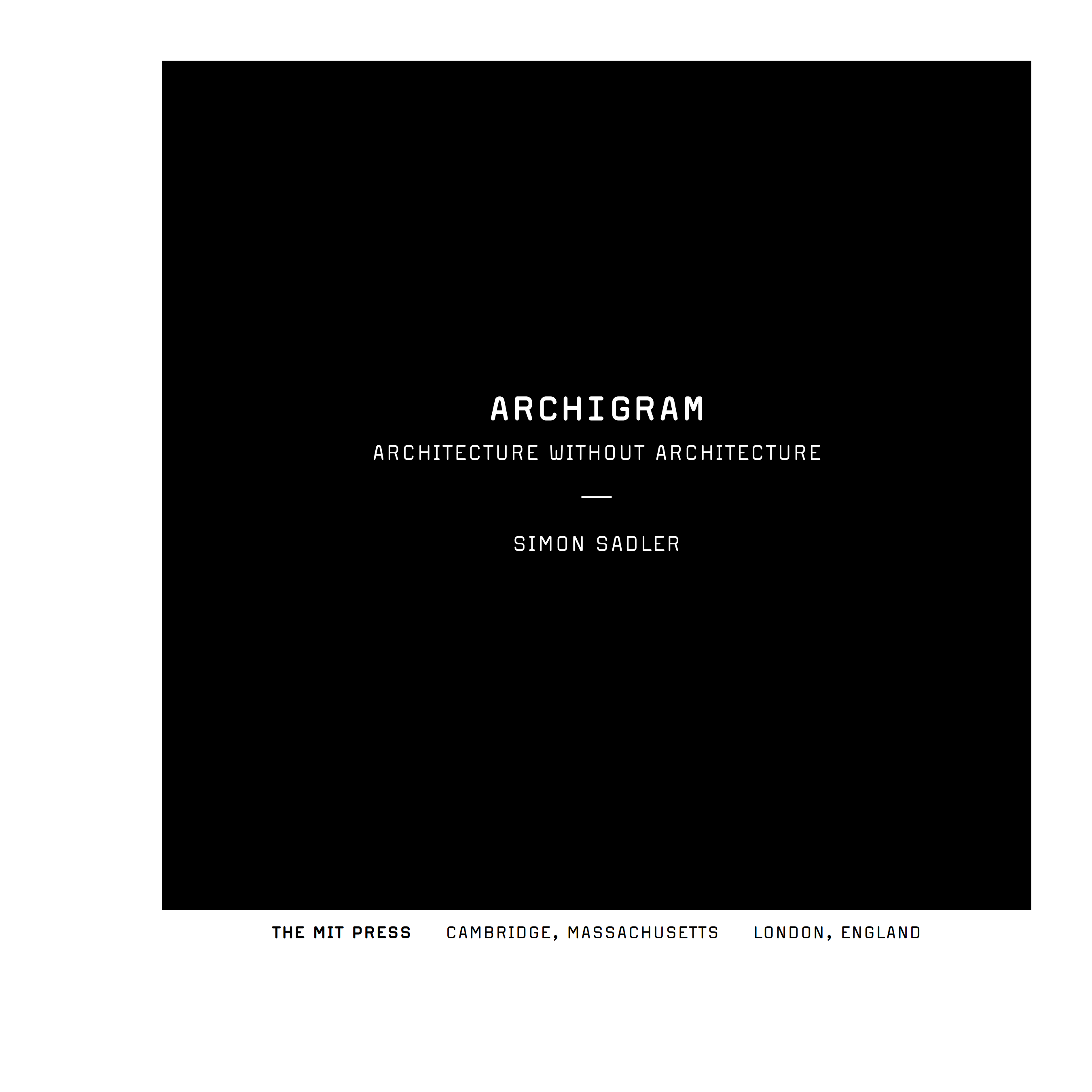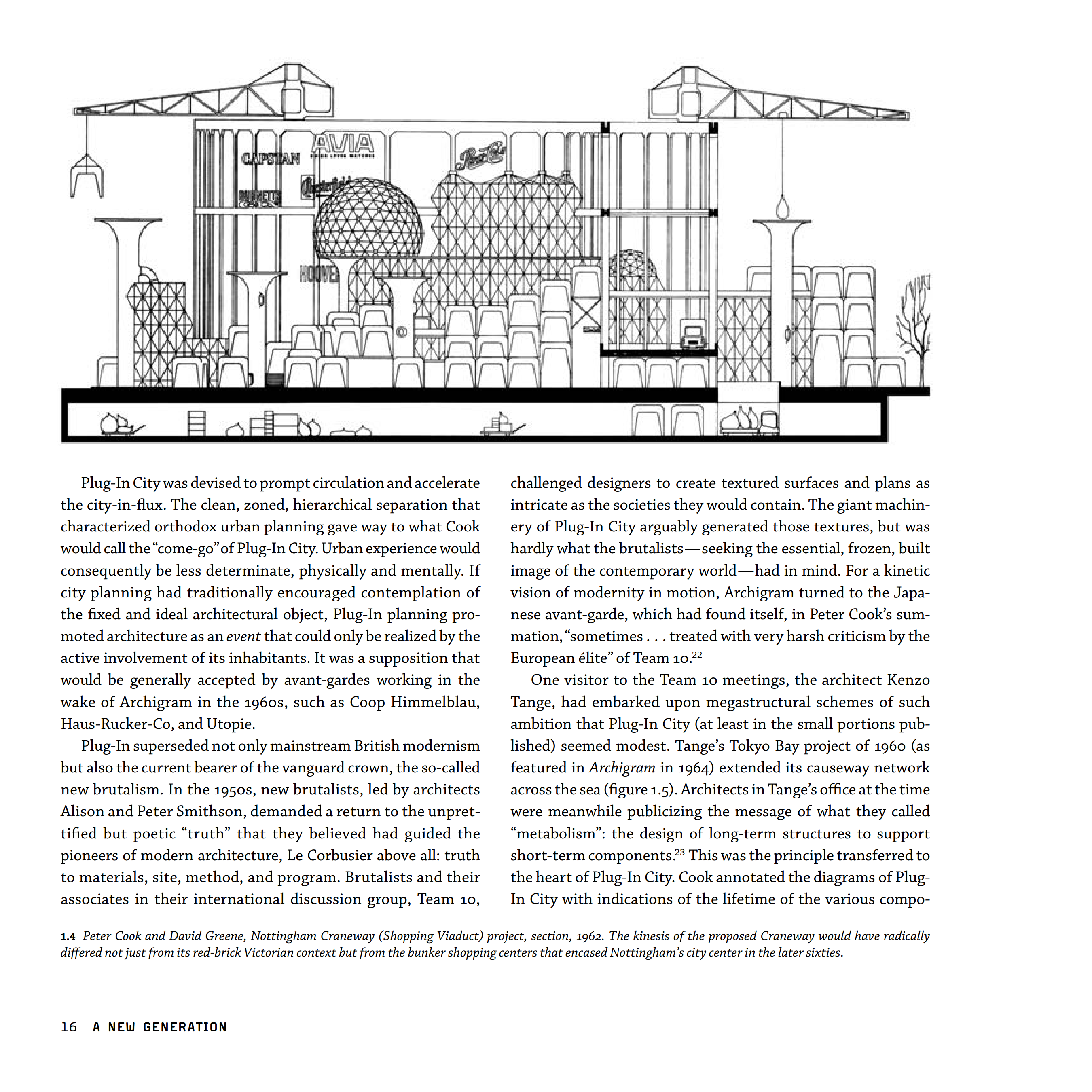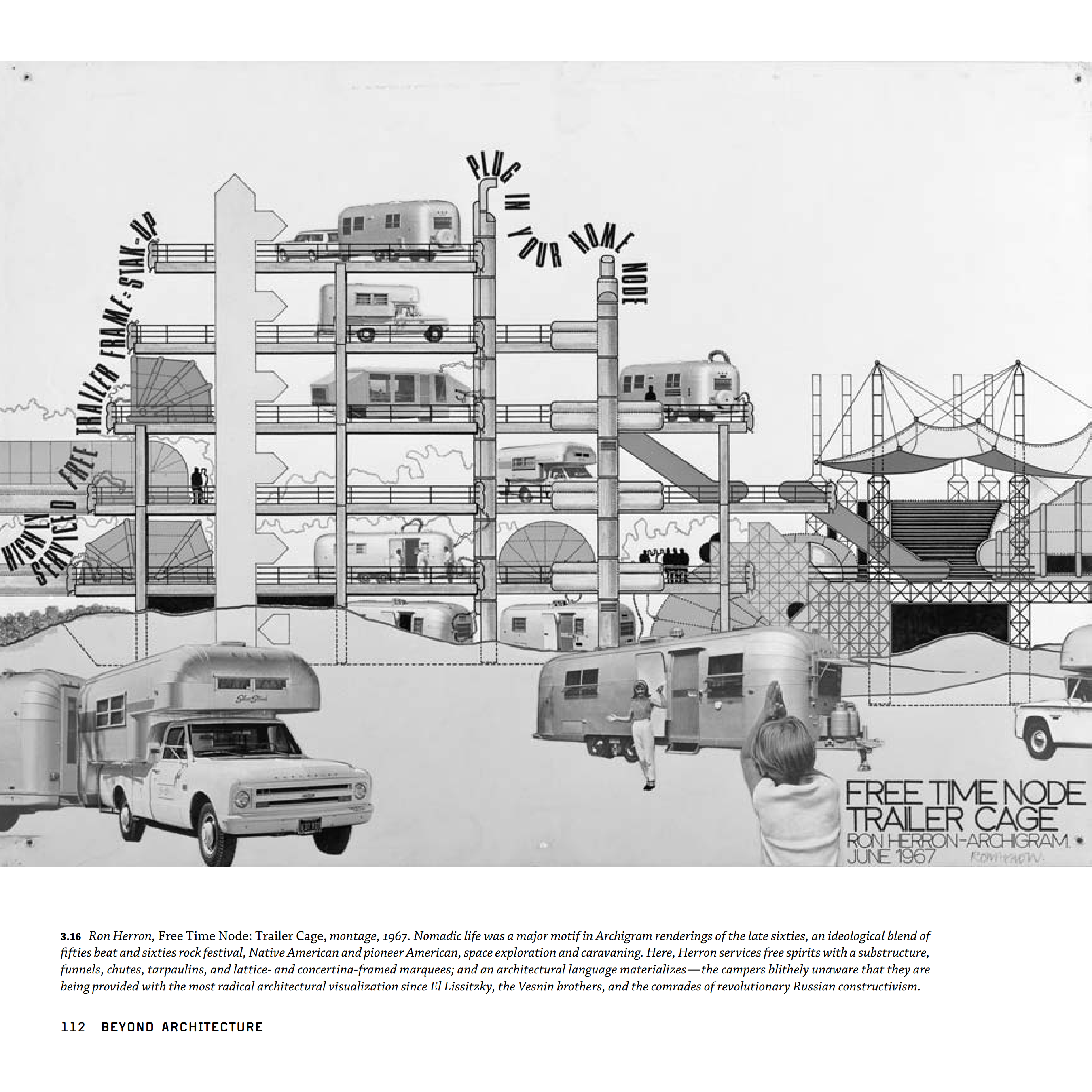|
|
Sadler S. Archigram : Architecture without architecture. — Cambridge ; London, 2005 Archigram : Architecture without architecture / Simon Sadler ; Massachusetts institute of technology. — Cambridge, Massachusetts ; London, England : The MIT Press, 2005. — X, 242 p., ill. — ISBN 0-262-69322-4
In the 1960s, the architects of Britain's Archigram group and Archigram magazine turned away from conventional architecture to propose cities that move and houses worn like suits of clothes. In drawings inspired by pop art and psychedelia, architecture floated away, tethered by wires, gantries, tubes, and trucks. In Archigram: Architecture without Architecture, Simon Sadler argues that Archigram's sense of fun takes its place beside the other cultural agitants of the 1960s, originating attitudes and techniques that became standard for architects rethinking social space and building technology. The Archigram style was assembled from the Apollo missions, constructivism, biology, manufacturing, electronics, and popular culture, inspiring an architectural movement -- High Tech -- and influencing the postmodern and deconstructivist trends of the late twentieth century.
Although most Archigram projects were at the limits of possibility and remained unbuilt, the six architects at the center of the movement, Warren Chalk, Peter Cook, Dennis Crompton, David Greene, Ron Herron, and Michael Webb, became a focal point for the architectural avant-garde, because they redefined the purpose of architecture. Countering the habitual building practice of setting walls and spaces in place, Archigram architects wanted to provide the equipment for amplified living, and they welcomed any cultural rearrangements that would ensue. Archigram: Architecture without Architecture -- the first full-length critical and historical account of the Archigram phenomenon -- traces Archigram from its rediscovery of early modernist verve through its courting of students, to its ascent to international notoriety for advocating the "disappearance of architecture."
CONTENTS
PREFACE viii
INTRODUCTION 2
1 A NEW GENERATION: ARCHIGRAM’S FORMATION AND ITS CONTEXT 10
2 THE LIVING CITY: POP URBANISM CIRCA 1963 52
3 BEYOND ARCHITECTURE: INDETERMINACY, SYSTEMS, AND THE DISSOLUTION OF BUILDINGS 90
4 THE ZOOM WAVE: ARCHIGRAM'S TEACHING AND RECEPTION 140
CONCLUSIONS 192
NOTES 198
BIBLIOGRAPHY 226
ILLUSTRATION CREDITS 233
INDEX 234
PREFACE
An understanding of neo-avant-garde architecture requires a critical summary of Archigram’s achievement, and in 1994 I started research on the problem at the Open University. As good-quality essays and catalogues on Archigram have appeared over the last decade, the absence of a full-length monograph has only become more noticeable. Given the rapid recent evolution of scholarly research into architectural neo-avant-gardes, we can likely look forward to further publications on more discrete aspects of Archigram’s work, or which conversely merge this work with other discourses. But for now, a book-length study presents the opportunity, as far as such a thing is possible, for an excursion into the Archigram moment as a whole.
This permits it to be seen as cultural, and not just narrowly architectural. Because Archigram was a partisan intervention into practice and publishing, the group’s drawings and texts are just as rewarding when read iconologically—as arguments about style, society, modernity, technology, and the architectural profession in the sixties—as they are when scrutinized for facts of architectural technique or principle, which often melt into the spectral haze of Archigram’s distinctive presentational style.
For more than forty years the provocative material recounted in this book has drawn both critique and apologia. Tempting though it is to write in similar veins, pursuant to the requirements of a credible architectural history this book neither scoffs at Archigram’s venture nor presents an “authorized biography” of the group. The latter would have been an exercise in futility even had I wanted to write one, since the careful observation of Archigram reveals subtle distinctions between its members’ purposes (despite attempts by the group and subsequent commentary to present the group as univocal). In addition, this book has to allow views of Archigram from outside observers—laudatory and antagonistic—to accompany Archigram’s self-perceptions.
Given my lack of accountability to the surviving members of the group which created my subject matter—Peter Cook, Dennis Crompton, David Greene, and Michael Webb—it is surely a tribute to their magnanimity that they listened to me in symposia, discussed their work with me, authorized its reproduction in my articles and chapters, and acceded de facto to the publication of this study when Archigram Archives released picture permissions (including those for Warren Chalk, who died in 1987) following complex negotiations in 2003-2004. Permission for the reprinting of work by Ron Herron, who died in 1994, was granted me by the Herron Estate.
The penalty for independent scholarship is that it cannot be privy to all extant records and artifacts, because the group’s various archives are not yet in the public realm. The interests of custodians and researchers should soon be reconciled, however, pending a joint funding bid between the University of Westminster, the Victoria and Albert Museum, the Archigram Archives, and the Herron Archives which will finally see Archigram’s physical effects catalogued, digitized, and transferred from their present confinement “under beds or behind walls.” It is also likely that additional archival material will be published in the near future. I remain beholden, in the interim, to Dennis Crompton of the Archigram Archives, and Simon Herron of the Herron Archives, for answering my steady stream of inquiries, retrieving archival material, and preparing it for this book.
Meanwhile the quantity of more readily available information pertaining to Archigram remains formidable. Whereas research for my previous MIT Press publication (on situationist urbanism) had to magnify evidence gleaned from libraries, long walks, conversational hints, fringe publications, and museum basements, reading rooms, and newly accessioned archives (which yielded the book’s arcane cover image), it is the task of the present publication somehow to survey and sample a prodigious bounty. An enormous number of Archigram’s drawings, models, and documents have become accessible through the big retrospective exhibitions that began with the Centre Pompidou show of 1994. Archigram published copiously, including its run of the legendary Archigram magazine, and it was discussed in dozens of articles and books around the world. There are any number of opinions and memories of the group to be logged and sifted, and the circumstantial record of the pop, technological, and libertarian cultures to which Archigram related is practically infinite.
Mentors, colleagues, and correspondents inestimably assisted with the assignment, though of course they will not necessarily sanction the book’s findings. Special mention must be made of the supervisors of the dissertation from which this book originated, Tim Benton and Barry Curtis, and of the further insight gained from examination by Iain Boyd Whyte and Nicholas Bullock. Other encounters—with Mary Banham, Hazel Cook, the late Catherine Cooke, Francois Dallegret, Paul Davies, Mark Fisher, Yona Friedman, Simon Herron, Malcolm Higgs, Craig Hodgetts, Diana Jowsey, the late Roy Landau, Arthur Marwick, Peter Murray, Brian Nicholls, Martin Pawley, Roy Payne, Monica Pidgeon, the late Cedric Price, Mary Quant, Tony Rickaby, Gordon Sainsbury, Paul Shepheard, Alan Stanton, and Peter Taylor—added detail and texture to my work. My hosts while visiting Michael Webb were Diane and Bill Menking.
I have been privileged to work again with the MIT Press and its staff, in particular executive editor Roger Conover, whose resolve is imprinted upon this book. Matthew Abbate and Derek George, production editor and designer respectively, saw the book to press.
Work on this study and its subsequent publication were made possible by generous financial aid from the Open University, Milton Keynes, 1995-1998; from the Paul Mellon Centre for Studies in British Art, London, 2002; and from the University of California, Davis, 2004.
Unexpectedly taxing in itself, this project was one strand of a challenging period in my life, into which Jan Wagstaff entered and thankfully stayed. Suffice it to say there are other people, some now distant from me or who played their parts perhaps unwittingly, whom I would acknowledge less notionally if I knew where to start or what to say to them.
THE BOOK IN BRIEF
The first chapter of this book, “A New Generation,” introduces Archigram as an attempt to recover the thrill of modernism’s pioneering phase, in protest against its later marshaling into a discipline. Occupying the ground already cleared by the London vanguards of the 1950s, the new brutalists and Independent Group, Archigram attempted to bring architecture up to speed with leading artistic, technological, and cultural tendencies—“pop” influences in particular.
This could be seen at Archigram’s 1963 show at the Institute of Contemporary Arts in London, “Living City,” the subject of the second chapter. “Living City” heralded a way of thinking about cities that later became commonplace: that cities, being more than mere functional organizations of space, are the life-support machinery of a culture in perpetual change. The exhibition’s fascination with the ephemeral made it significant to the longer trajectory that Archigram was taking: one that would affect the “disappearance” of architecture.
This was the most remarkable aspect of Archigram’s work at its peak, and is described in the third chapter, “Beyond Architecture.” Architectural disappearance was the logical outcome of the thus-far “repressed” strain of modernism: the one that wanted to defeat monumentality by composing buildings out of industrially produced, interchangeable and ultimately disposable “kits-of-parts.” Thereby the task of architecture would be passed from the architect to the user-client. The context of this project was a dispersed range of ideas from the 1960s about the nature of freedom—spatial, creative, consumerist, political, echoed in the fine arts at that time by the drive “beyond the object” and amongst other architectural provocateurs such as Bernard Rudofsky (whose famous 1964 exhibition and catalogue Architecture without Architects is a reference for this book’s title).
A very peculiar politics thus emerges around Archigram, often rendered insensitive to emergent political movements (especially feminism and ecology) by its sheer macho enthusiasm for modernity. And this, the book suggests, is one of the things that makes Archigram a case study of the ideological disorder encountered in a bid for complete freedom. Archigram indicates a version of the sixties that does not readily emerge in histories of the period—avowedly “apolitical” rather than “engaged,” technocratic rather than anarchic, individualist rather than “hippie,” grounded as much in 1950s assumptions of affluence as 1960s commitments to redistribution.
These politics are discussed as well in the fourth and final chapter, “The Zoom Wave,” where Archigram’s influences, on segments of the student populace in particular, are outlined. The limits of its reach are also plotted. To a great extent Archigram came out of, and was sustained by, the schools of architecture, and it was nourished by a high ideal of what education, and architectural education in particular, should be about: the cultivation of individuals working in concert, uninstitutionalized.
More visibly, Archigram created a style—assembled from nineteenth-century industrial architecture, twentieth-century manufacturing, military apparatus, science fiction, biology, technology, electronics, constructivism, pop art, cutaway technical illustration, psychedelia, and the English seaside—which would serve as an inspiration for an architectural movement, high-tech, and feed into the stream of postmodern/deconstructivist trends of the 1970s, 1980s, and 1990s. In the process of demonstrating the potential of technology to create deformations and nonmonumental networks, Archigram became radical stylists of technology. More yet than Archigram’s hero Richard Buckminster Fuller (widely remembered for the geodesic dome), the new prophets of architectural antiform turned out to have an antithetical legacy as form-givers, tethering domes, inflatables, pods, and billboards with wires, gantries, tubes, tracks, trucks, and logs. The group imagined releasing building’s latent energy not through sculpting but through electrical and mechanical impulses, dictated by social activity and projected by images and writhing vinyl. With its instantly recognizable style, Archigram had paradoxically found form in the equipment of events.
If Archigram’s contribution to the arts of the sixties and its stylistic bequest to high-tech architecture are now historically acknowledged, its counsel on designing in a “postindustrial,” “informational,” “globalized” age might be less apparent—and could account for the resurgence of curiosity about Archigram three decades after it closed its office. Because while many of the marvels Archigram predicted eventually became accessible through the flat screen of the computer monitor, few manifested themselves three-dimensionally or with such flair.
Примеры страниц 
Скачать издание в формате pdf (яндексдиск; 10,4 МБ).
Все авторские права на данный материал сохраняются за правообладателем. Электронная версия публикуется исключительно для использования в информационных, научных, учебных или культурных целях. Любое коммерческое использование запрещено. В случае возникновения вопросов в сфере авторских прав пишите по адресу 42@tehne.com.
1 июня 2016, 20:02
0 комментариев
|
Партнёры
|







Комментарии
Добавить комментарий